KYRG-11
RSP 11051
Grower: Landrace kyrgyzstan
General Information
- Sample Name
- Kxrgyz-L3
- Accession Date
- February 5, 2018
- Reported Plant Sex
- not reported
- Report Type
- StrainSEEK v2 3.2Mb
- DNA Extracted From
- Stem
The strain rarity visualization shows how distant the strain is from the other cultivars in the Kannapedia database. The y-axis represents genetic distance, getting farther as you go up. The width of the visualization at any position along the y-axis shows how many strains there are in the database at that genetic distance. So, a common strain will have a more bottom-heavy shape, while uncommon and rare cultivars will have a visualization that is generally shifted towards the top.
Chemical Information
Cannabinoid and terpenoid information provided by the grower.
Cannabinoids
No information provided.
Terpenoids
No information provided.
Genetic Information
- Plant Type
- Type III
File Downloads
The bell curve in the heterozygosity visualization shows the distribution of heterozygosity levels for cannabis cultivars in the Kannapedia database. The green line shows where this particular strain fits within the distribution. Heterozygosity is associated with heterosis (aka hybrid vigor) but also leads to the production of more variable offspring. When plants have two genetically different parents, heterozygosity levels will be higher than if it has been inbred or backcrossed repeatedly.
The ratio of reads mapped to Y-contigs to reads mapped to the whole Cannabis genome (Y-ratios) has been demonstrated to be strongly correlated with plant sex typing. This plot shows the distribution of Y-ratios for all samples in our database which were sequenced with the same method (panel or WGS) as this sample and where this sample falls in the distribution.
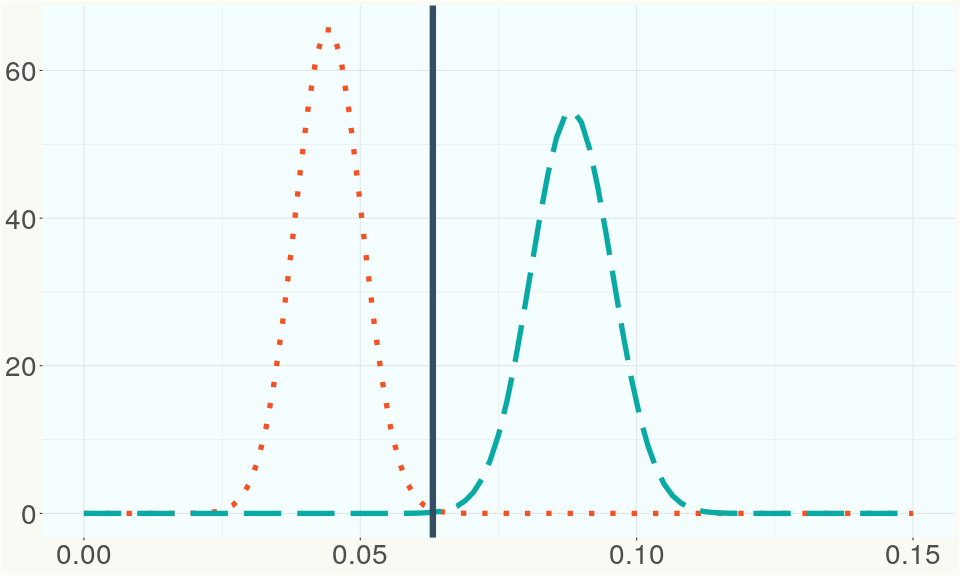
This chart represents the Illumina sequence coverage over the Bt/Bd allele. These are the three regions in the cannabis genome that impact THCA, CBDA, CBGA production. Coverage over the Active CBDAS gene is highly correlated with Type II and Type III plants as described by Etienne de Meijer. Coverage over the THCA gene is highly correlated with Type I and Type II plants but is anti-correlated with Type III plants. Type I plants require coverage over the inactive CBDA loci and no coverage over the Active CBDA gene. Lack of coverage over the Active CBDA and Active THCA allele are presumed to be Type IV plants (CBGA dominant). While deletions of entire THCAS and CBDAS genes are the most common Bt:Bd alleles observed, it is possible to have plants with these genes where functional expression of the enzyme is disrupted by deactivating point mutations (Kojoma et al. 2006).
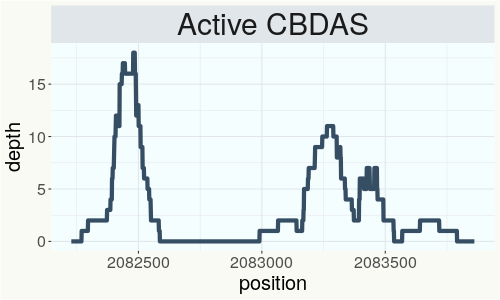
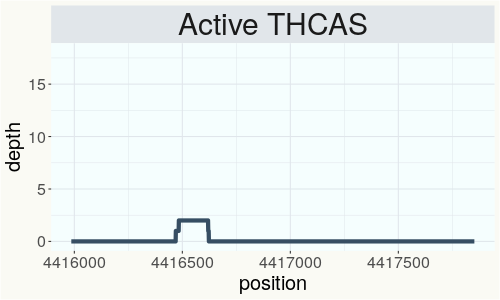
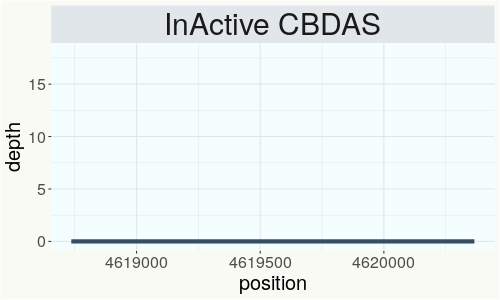
This chart represents the Illumina sequence coverage over the CBCA synthase gene.
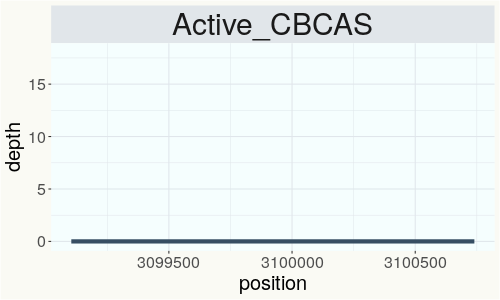
Variants (THCAS, CBDAS, and CBCAS)
No variants to report
Variants (Select Genes of Interest)
| PKSG-2a | c.67T>A | p.Phe23Ile | missense variant | moderate | contig700 | 1945567 | A/T | |
| PKSG-2a | c.31A>T | p.Thr11Ser | missense variant | moderate | contig700 | 1945603 | T/A | |
| PKSG-2b | c.31A>T | p.Thr11Ser | missense variant | moderate | contig700 | 1951851 | T/A | |
| aPT4 | c.626A>G | p.Asn209Ser | missense variant | moderate | contig121 | 2830904 | A/G |
|
| aPT1 | c.406A>G | p.Ile136Val | missense variant | moderate | contig121 | 2839605 | A/G |
Nearest genetic relatives (All Samples)
- 0.209 KYRG-151 (RSP11052)
- 0.215 Kyrgyz Gold (RSP11054)
- 0.216 Tygra (RSP10667)
- 0.217 Santhica27 (RSP10056)
- 0.218 Carmagnola (RSP10982)
- 0.219 XUM2 (SRR14708204)
- 0.221 Carmagnola (RSP10979)
- 0.224 Carmagnola (RSP11039)
- 0.225 KYRG-21 (RSP11053)
- 0.227 Carmagnola (RSP10655)
- 0.227 Futura 75 (RSP10664)
- 0.228 Carmagnola (RSP10978)
- 0.229 USO 31 (RSP10983)
- 0.229 Santhica 27 (RSP10665)
- 0.232 Tisza (RSP10659)
- 0.232 XHC2 (SRR14708210)
- 0.235 Lovrin (RSP10658)
- 0.235 Carmagnola (RSP10980)
- 0.236 C-930 lot 211005 (RSP12603)
- 0.237 QHI (SRR14708202)
Most genetically distant strains (All Samples)
- 0.434 Cherry Blossom (RSP11323)
- 0.434 Cherry Blossom (RSP11318)
- 0.427 Cherry Blossom (RSP11301)
- 0.423 Chem 91 (RSP11185)
- 0.421 Cherry Blossom (RSP11312)
- 0.418 Cherry Blossom (RSP11311)
- 0.415 Cherry Blossom (RSP11298)
- 0.415 Cherry Blossom (RSP11328)
- 0.412 Unknown--Cherry Wine---001- (RSP11268)
- 0.408 Cherry Blossom (RSP11300)
- 0.403 BagSeed (RSP12627)
- 0.401 Cherry Blossom (RSP11334)
- 0.398 Chematonic -Cannatonic x Chemdawg- (RSP11394)
- 0.398 Cherry Blossom (RSP11319)
- 0.397 Cherry Blossom (RSP11309)
- 0.397 Cherry Blossom (RSP11321)
- 0.396 Cherry Blossom (RSP11331)
- 0.395 QLE1 (RSP11451)
- 0.393 Northern Lights (RSP11501)
- 0.391 GMO x Garlic Breath (RSP12507)
Nearest genetic relative in Phylos dataset
- Overlapping SNPs:
- 69
- Concordance:
- 43
Nearest genetic relative in Lynch dataset
- Overlapping SNPs:
- 4
- Concordance:
- 4
Blockchain Registration Information
- Transaction ID
-
8925ec04fd2ae2a4
9643dfb7df0a859f c90229622e2c6d1f 026c87caead6f074 - Stamping Certificate
- Download PDF (854.0 KB)
- SHASUM Hash
-
592c7de2979ddbcf63eadd52a170f742 52c5737fd2815428 6cd05707eb0be1f8